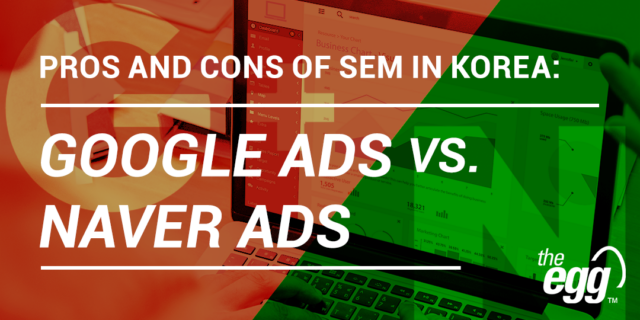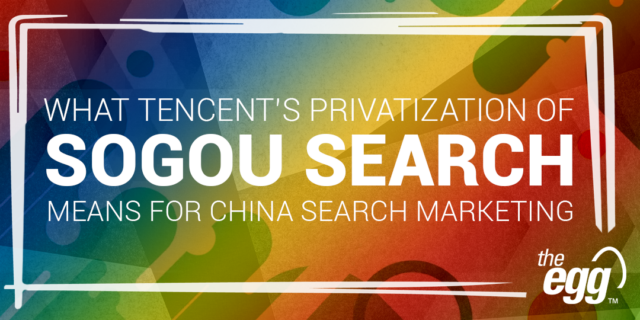How To Advertise On Linkedin (Bonus: Best Practices And Mistakes To Avoid)
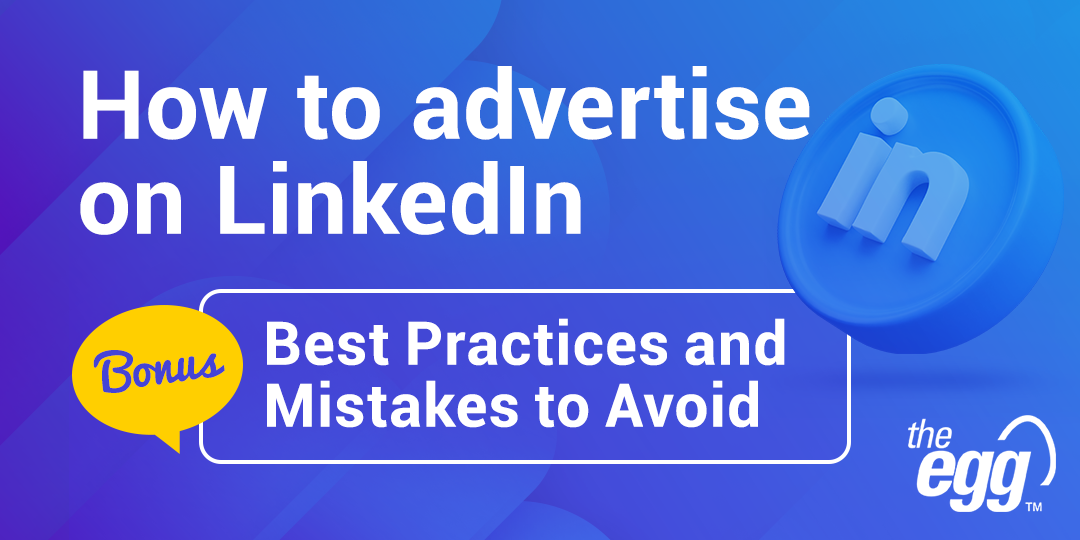
As the world’s largest professional network with over 1 billion members worldwide, LinkedIn offers significant opportunities for generating high-quality leads. The attributes available in LinkedIn profiles, such as experience, employment, qualifications, and education, allow you to connect with individuals who are likely to be interested in and respond positively to your messaging, products, and services.
A key component of LinkedIn’s business model are LinkedIn ads, enabling companies to run paid ads aimed at specific professional demographics. These paid advertisements offer businesses substantial opportunities to connect with potential clients, partners, and top talent within the professional sphere.
Why choose LinkedIn?
LinkedIn is a great professional platform that provides attractive benefits for your advertising needs. It’s an excellent choice for businesses looking to reach and connect with targeted professionals effectively. According to LinkedIn,
- 4 out of 5 LinkedIn members are key decision-makers in their businesses, allowing you to reach influential professionals who drive business decisions.
- The audience on LinkedIn has double the influence of the average web user, meaning your ads are seen by individuals with significant buying power.
- LinkedIn users are six times more likely to convert, ensuring a higher return on investment and a greater success rate for your advertising campaigns.
WHAT IS YOUR ADVERTISING OBJECTIVE?
What do you want customers to do once they see the ad? Those actions are grouped into 3 categories: awareness, consideration and conversion, targeting different stages of the marketing funnel.
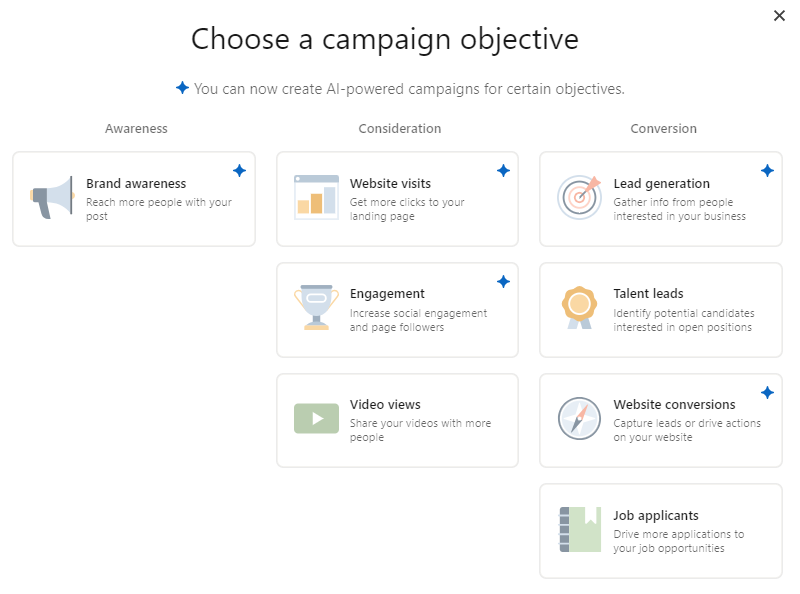
Awareness:
- Objective: Build brand recognition and ensure your audience becomes familiar with your brand name, values, and products or services.
- Types of Ads: These typically include Single Image, Carousel Image, Follower Ads, Spotlight Ads and many more.
- Examples include ads that introduce your brand to a wider audience, highlight what sets your company apart, or showcase visually appealing imagery or videos to leave a lasting impression.
- Metrics: Key performance indicators (KPIs) for awareness campaigns often focus on impressions, reach, and increased brand visibility.
Consideration:
- Objective: Engage your audience and encourage them to interact with your brand. This phase focuses on nurturing interest and driving traffic to your content.
- Types of Ads: Single Image, Video Ads, Conversation , and Carousel Ads are frequently used here.
- Examples include ads that offer valuable content such as blog posts, webinars, whitepapers, or eBooks that customers might find useful.
- Metrics: KPIs for consideration campaigns might include click-through rates (CTR), engagement rates, social interactions (likes, shares, comments), and website visits.
Conversion:
- Objective: Drive specific actions from your audience that contribute to your business goals, such as generating leads, acquiring new customers, or making sales.
- Types of Ads: Lead Generation Forms, Document Ads and Conversation Ads are commonly used for conversion-focused campaigns.
- Examples include ads that contain a call to action (CTA) like signing up for a free trial, downloading a guide, filling out a form, or making a purchase.
- Metrics: KPIs for conversion campaigns often focus on conversion rates, cost per conversion, number of leads generated, and return on ad spend (ROAS).
Targeting Options:
What are LinkedIn’s targeting options
LinkedIn advertising lets you choose from over 20 audience attributes, some of which include:
- Company size
- Company name
- Educational institutions
- Interests
- Groups
- Skills
- Job title
- Job seniority
Although it can be tempting to pick as many targeting options as possible, this may narrow your audience too much, which can significantly limit your reach.
Another common mistake is over-targeting Director and executive audiences while leaving out critical decision-makers below that level of seniority. The upper echelons of the corporate ladder are often flooded with endless waves of marketing messages and instead tend to rely on their teams to filter recommendations and even make critical decisions.
Pro Tip: Avoid hypertargeting! Instead, target individual contributors and managers but filter by years of experience to focus on experts in the field.
LinkedIn provides suggested keywords of skills, job titles, company names, and groups. Thus, helping to pick one or two of these suggestions to capture relevant audience members who might have otherwise been missed.
If a campaign is not achieving the necessary scale to meet goals, LinkedIn’s Audience Expansion feature eliminates the guesswork and can help find new audiences based on your selected targeting criteria.
Audience Targeting Tools
LinkedIn offers robust targeting tools to help advertisers reach their intended audience more effectively. The three key targeting tools—Predictive Audiences, Audience Insights, and Matched Audiences—each serve unique purposes and work differently to optimize your LinkedIn advertising efforts.
Predictive Audiences:
- How It Works: Predictive Audiences use AI to identify and target audiences that are most likely to engage with your campaign based on historical behavior, demographics, and interests. This tool is designed to predict which members are likely to convert, thereby improving the efficiency and effectiveness of your campaigns.
- Usage: To use Predictive Audiences, you generally choose a predefined audience that LinkedIn suggests based on their predictive model. This could include lookalike audiences or audiences segmented by engagement likelihood, and you can choose your data source (Lead Gen Form, Contact Lists, and Conversions).
- Benefits: This tool helps you reach high-potential leads without requiring deep data analysis on your part, making it easier to achieve better ROI.
Audience Insights:
- How It Works: Audience Insights provide detailed information about the composition and behavior of your targeted audience. This includes demographic data (e.g., job titles, seniority levels, industries), engagement metrics, and activity patterns on the LinkedIn platform.
- Usage: View Audience Insights to understand who is engaging with your content and how. This data can inform your targeting strategy, content creation, and ad optimization.
- Benefits: By analyzing these insights, you can refine your targeting parameters, ensuring that your ads reach the most relevant and engaged audience. It also helps tailor your messaging and creative to better resonate with your target market.
Matched Audiences:
- How It Works: Matched Audiences allow you to upload your own data, such as email lists or CRM contacts, and match them with LinkedIn members. This tool creates highly personalized and relevant targeting segments based on your own audience data.
- Types: Matched Audiences can include:
- Retargeting: Target people who have visited your website.
- Contact Targeting: Upload a list of contacts or email addresses to target them specifically.
- Company Targeting: Target companies from a list of accounts you are interested in.
- Usage: You upload your data file, which LinkedIn then matches against its user base to create a custom audience. Once the audience is created, you can deliver personalized ads directly to these people.
- Benefits: This allows you to re-engage with website visitors, nurture leads from your CRM, and target decision-makers at specific companies, thereby enhancing the precision and relevance of your campaigns.
By leveraging these targeting tools, LinkedIn advertisers can effectively reach and engage their desired audience with tailored messages, increasing the likelihood of achieving their campaign goals.
Ad Types and Formats
At the time of writing, LinkedIn offers 4 types of ads: Sponsored Content, Sponsored Messaging, Lead Gen Forms, and Text and Dynamic Ads, and each comes in a variety of formats. Here are some notable ones:
LINKEDIN SPONSORED CONTENT
LinkedIn sponsored ads appear on LinkedIn feeds of professionals you want to target and can display as single images, videos, carousel, event or document ads. This means you can target your most valuable audiences according to profile-based user data.
Eg.
Single Image Ads
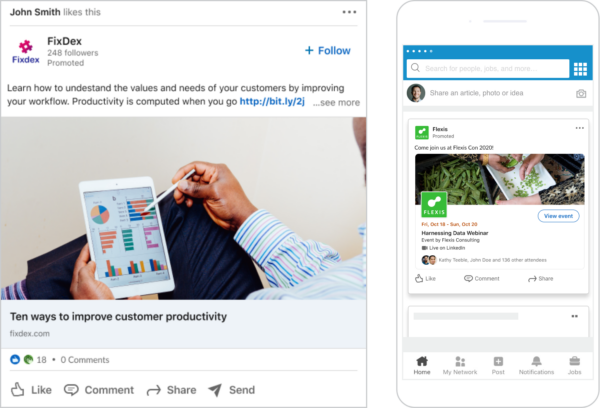
Video Ads
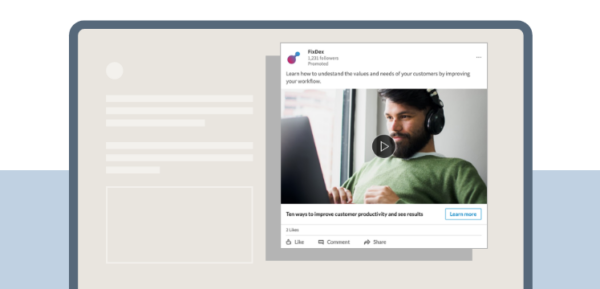
Carousel Ads
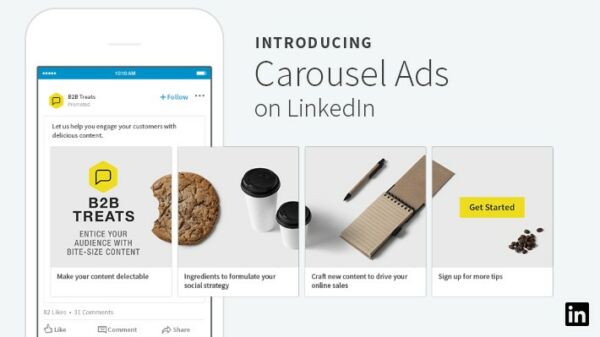
There are many more formats like Documents ads or Event ads.
LINKEDIN SPONSORED MESSAGING
LinkedIn sponsored messaging facilitates targeting via LinkedIn messaging, where professionals increasingly spend their time building relationships. It is proven to drive stronger response rates than traditional email marketing campaigns. These include conversation and message ads.
Eg.
Conversation Ads
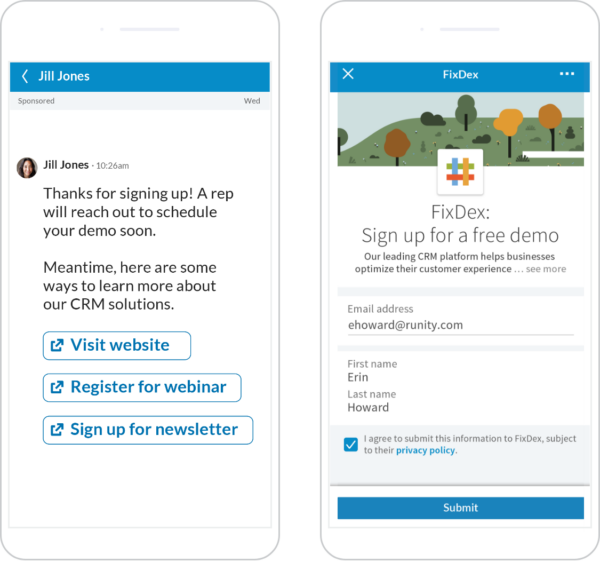
Message Ads
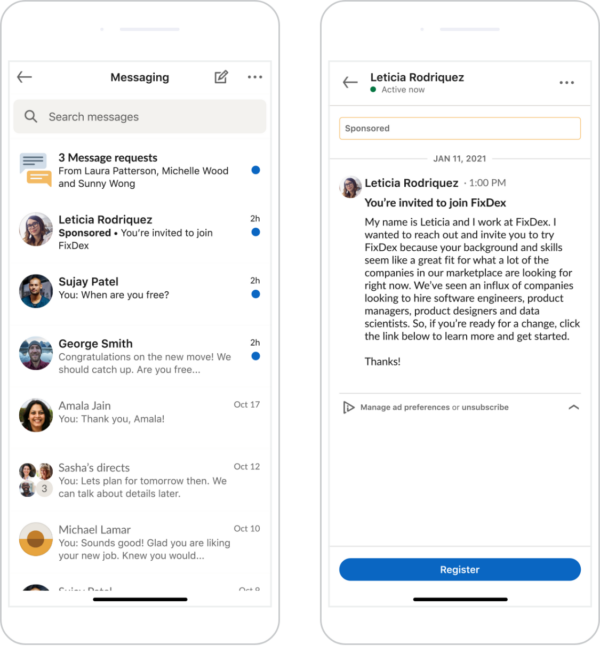
LINKEDIN LEAD GEN FORMS
LinkedIn Lead Gen Forms streamline the process of collecting high-quality leads by allowing users to submit their information directly within the LinkedIn platform. When a user clicks on a LinkedIn ad that uses a Lead Gen Form, an in-platform form opens pre-filled with their LinkedIn profile data, such as name, contact details, and work information. This reduces friction for the user and increases conversion rates by simplifying the data submission process.
Lead Gen Forms are ideal for capturing information for content downloads, event registrations, or any lead generation objective.
LINKEDIN TEXT AND DYNAMIC ADS
Ads in this category primarily appear on the right rail of the desktop version, making them a great choice for targeting desktop audiences based on professional attributes like job titles and industry.
LinkedIn Text Ads are straightforward, featuring short headlines, brief descriptions, and small images.
In contrast, LinkedIn Dynamic Ads personalizes ad content with profile data—such as profile photos, company names, and job titles—for each viewer. This personalization can drive specific actions, such as event registrations or job applications. Dynamic Ads include formats like Spotlight and Follower ads, which can also appear in-feed on mobile devices, offering broader placement options and deeper personalization compared to Text Ads.
Text Ads
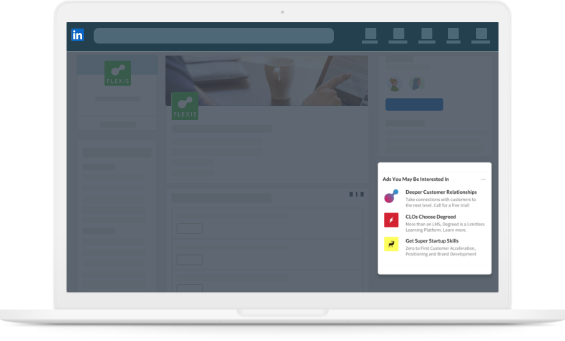
Spotlight Ads
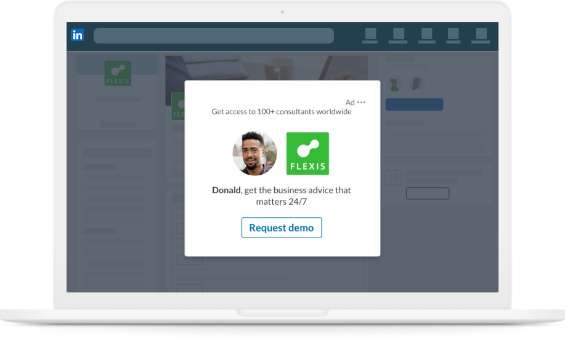
WANT DIGITAL INSIGHTS STRAIGHT TO YOUR INBOX?
Bidding types
LinkedIn advertising has three distinctive bid types designed to cater to different campaign goals: Maximum Delivery, Cost Cap, and Manual.
- Maximum Delivery: Imagine a fully automated assistant that knows exactly how to stretch every penny of your budget while maximizing key results. That’s Maximum Delivery for you! This option leverages LinkedIn’s sophisticated algorithms to set your bid, ensuring your budget is fully utilized to achieve the highest possible impact.
- Cost Cap: For those who crave a balance between automation and cost control, Cost Cap is the way to go. Available for CPC (cost-per-click), CPM (cost-per-thousand-impressions), CPV (cost-per-view), and CPL (cost-per-lead) campaigns, this bid type allows you to set a preferred cost per key result. LinkedIn’s system then works diligently to keep your costs close to that specified amount.
- Manual Bidding: Are you a hands-on marketer who loves to steer the ship directly? Manual Bidding grants you the ultimate control over your advertising auction. You get to enter your bid value, and that’s exactly what is used in the competition for ad placements. While it requires regular monitoring to optimize performance, the level of precision and control you have can be incredibly rewarding.
With these three dynamic bid types, you can tailor your advertising efforts precisely to your strategies and budgets. Whether you prefer full automation, controlled costs, or direct oversight, there’s a bid type just for you.
How can you measure and optimize your LinkedIn Ads?
Measure
- Set Clear Objectives: Define what success looks like for your ads, whether it’s brand awareness, lead generation, engagement, or conversions.
- Use LinkedIn Campaign Manager: Monitor key metrics such as click-through rates (CTR), cost per click (CPC), cost per impression (CPM), and conversion rates within LinkedIn’s Campaign Manager to help you make data-driven decisions.
- Leverage LinkedIn Insight Tag: Install the LinkedIn Insight Tag on your website to track conversions, retarget visitors, and gain deeper insights into your audience’s behavior.
- Review Engagement Metrics: Assess engagement metrics, such as likes, shares, and comments, to gauge audience interaction.
Optimize
- A/B Testing: Conduct A/B tests on different ad variants, including headlines, images, call-to-actions, and targeting options to determine what resonates best with your audience.
- Monitor Demographics: Analyze demographic data to understand which audiences are engaging most with your ads, and adjust targeting accordingly.
- Optimize Ad Content: Regularly update and refine your ad content based on performance data to keep your ads fresh and engaging.
- Optimize Landing Pages: Ensure your landing pages are optimized for conversions, with clear messaging, quick load times, and easy navigation.
- Budget Reallocation: Reallocate your budget to the best-performing ads and campaigns to maximize results.
lINKEDiN adVERTISING: Common mistakes to avoid
- Hypertargeting: Hypertargeting in LinkedIn ads can be detrimental due to its overly narrow audience reach, excluding potential prospects who don’t fit strict criteria. This leads to higher costs per lead, reduced scalability, and misses out on discovering unexpected valuable market segments, ultimately lowering campaign effectiveness and ROI.
- Not using conversion tracking: It hinders accurate performance measurement and ROI calculation, making it difficult to assess campaign effectiveness. Without conversion data, you miss essential insights for optimizing campaigns and reallocating budget to high-performing ads. This affects tracking specific business goals like lead generation or sales, limiting your ability to make data-driven decisions and achieve better advertising outcomes.
- Budget Burn without Prior Testing: It is important to avoid allocating your entire budget to a single campaign without prior testing, as this can lead to inefficient spending and suboptimal results. Start with a smaller budget to test various ad variations, audiences, and strategies, and continuously analyze key performance metrics (such as CTR, engagement rate and conversion rate) to identify the most effective ad creatives and target segments. This approach minimizes the risk of budget burn, helps you allocate resources more efficiently, and enhances overall engagement and ROI by allowing you to learn and adapt to your audience’s preferences in real-time.
LinkedIn ADVERTISING: Best Practices
- Square visuals: Ad creatives on LinkedIn should be square as they occupy more screen space on mobile devices, capturing more attention from users. With an increasing share of LinkedIn users accessing the platform via mobile, it is essential to gear our marketing strategy towards mobile optimization.
- At least 4-5 assets per campaign: Multiple assets allow for A/B testing to identify top performers and cater to diverse audience preferences, reducing ad fatigue by offering variety. LinkedIn’s algorithm can optimize delivery based on asset performance, enhancing overall campaign effectiveness. Additionally, a diverse set of assets provides broader insights, informing better future campaign decisions.
- Creating buyer personas: Buyer personas help you understand your target audience’s demographics, interests, pain points, and behavior. This information allows you to tailor your ad messaging, content, and targeting more effectively, ensuring your ads resonate with the right audience.
- Ad library to check for competition: Checking the LinkedIn ad library for inspiration before creating ads is beneficial because it offers insights into successful ad formats, messaging, and design trends used by competitors and industry leaders. It can spark creative ideas, save time during the brainstorming process, and guide you to align with best practices that improve ad performance.
- Create gated offers for primary research-based content: This approach creates a sense of exclusivity, increasing the perceived value of your content and encouraging meaningful interactions with your brand.
Conclusion
Harnessing the power of LinkedIn advertising can be a game-changer for businesses committed to connecting with the right professional audience. When executed thoughtfully, LinkedIn advertising becomes more than a marketing effort; it transforms into a pivotal strategy for business growth, brand recognition, and meaningful interactions within the professional community.
However, achieving success requires not only a deep understanding of LinkedIn’s advertising tools and best practices but also the experience and expertise to implement them seamlessly.
As a seasoned agency specializing in paid media, we possess the insights, tools, and strategies necessary for driving impactful results. Let us be your trusted partner in transforming your advertising efforts. With our expertise, you can effortlessly navigate the complexities of LinkedIn marketing, avoid common pitfalls, and achieve your business goals.
Reach out today to discover how we can help you elevate your LinkedIn advertising campaigns.



